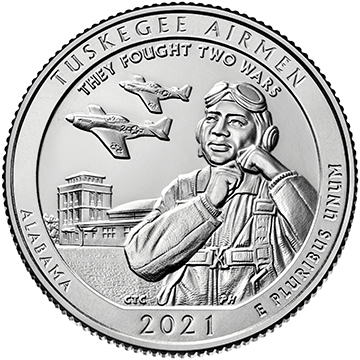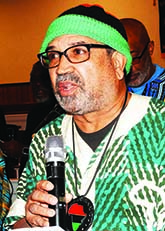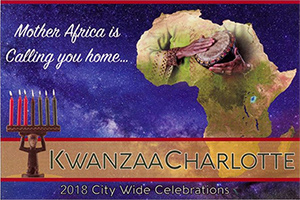
The Tuskegee Quarter and the Double V Campaign

By Makheru Bradley

The Tuskegee Airmen
The United States Mint announced in January that it was releasing a 2021 “America the Beautiful Quarter” honoring the Tuskegee Airmen National Historic Site. This quarter with George Washington on one side, will have on the other side, a Tuskegee Airman, the Moton control tower, and two P-51 Mustangs overhead. The words “Tuskegee Airmen” and “They Fought Two Wars” are written across the top of the back of this quarter.
The remarkable story of the Tuskegee Airmen begins with C. Alfred "Chief" Anderson who became the first Afrikan American to receive a commercial pilot's license in 1932. Anderson is also known as the pilot who flew Eleanor Roosevelt, the wife U.S. President Franklin D. Roosevelt. He convinced Mrs. Roosevelt to ask her husband to establish a military flight training school at Tuskegee.
President Roosevelt agreed and authorized a U.S. Army Air Corps contract for Tuskegee to help train America's first Black military aviators. Tuskegee had already invested in the development of Moton (Air) Field, named for Tuskegee University's second President, Dr. Robert R. Moton. They also had a civilian pilot training program for their students. It was the logical choice for a military aviation program.
Over 1,000 Black pilots were trained at Tuskegee from 1941 to 1946. Known as the “Red Tails,” the Tuskegee Airmen were so successful in escorting Allied bombers during World War II, having one of the lowest loss records of all the escort fighter groups that they were in constant demand for their services. The Airmen were awarded several Presidential Unit Citations for their tactical air support and aerial combat in Italy and Germany, including their longest bomber escort mission to Berlin on March 24, 1945.
“They Fought Two Wars”
The Tuskegee Airmen were part of the historic and heroic struggle of Afrikan Americans during World War II, against racism in America and against fascism abroad. This struggle became known as the “Double V Campaign.”
The Double V Campaign started with a letter published in The Pittsburgh Courier, then the largest black newspaper in the United States, on January 31, 1942. The letter was titled, “Should I Sacrifice to live Half American?” It was written by 26-year-old defense worker James G. Thompson, who criticized the discrimination he faced in a Wichita, Kansas plant. The theme was consistent with the views of the Courier which made a connection between the United States’ treatment of Afrikan Americans and Nazi Germany’s treatment of Jews.
Thompson’s letter noted the popular American “V for Victory” sign, referring to victory over fascism and the horrors of the Axis powers. He called for a “double VV for victory” sign, with the V’s standing for victory over the fascists abroad and over the racists at home.
The Courier on February 7, 1942, published on its front page a “Double V” insignia, announcing the “Democracy at Home-Abroad” slogan. The slogan became immensely popular with Afrikan American civilians, including over 6 million who were working in WWII defense plants and with over one million Afrikan Americans serving in the US military.
Many historians see a clear relationship between the popularity of the Double V Campaign and the growth of the Civil Rights Movement after WWII and the Korean War. The brave Afrikan Americans who fought in WWII and those who built bombers in defense plants succeeded abroad. At home many of the structures of white supremacy were torn down by the Civil Rights Movement, but the foundation remained intact. On that foundation refinements of white supremacy have emerged.
I remember my father, a WWII vet, being appalled in the 1980s when he heard about the presence and activities of Neo-Nazi Skinheads in the US. He said, we fought those demons over there, looks like we're going to have to fight them over here. His prediction has come true. Given the emergence of fascist forces in the US, the two wars our forefathers/mothers fought in the 1940s will have to be fought in the US in the 2020s.
For more from the author, follow his blog Makheru Speaks.


